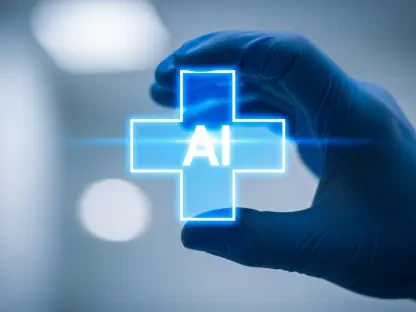In today’s rapidly evolving technological landscape, digital transformation is making monumental strides in reshaping healthcare. This transformation is evident in the substantial market growth projected from USD 65.2 billion in 2023 to a staggering USD 253.6 billion by 2033. Fueled by a compounded annual growth rate of 14.5%, the integration of advanced technologies is not only optimizing patient care but also revolutionizing the overall healthcare infrastructure.
The Rise of Telehealth and Mobile Health Solutions
Enhancing Accessibility and Care Delivery
Telehealth solutions have emerged as a beacon of hope, especially in regions grappling with healthcare accessibility issues. With an ever-increasing number of individuals relying on telehealth services, healthcare providers can now offer consultations and follow-ups remotely, breaking geographical barriers and ensuring timely medical intervention.
Moreover, the convenience of mobile health applications adds another layer of accessibility. These apps allow patients to monitor their health metrics, schedule appointments, and even access medical records with just a few taps on their smartphones. This increased accessibility is crucial for managing chronic illnesses, where regular monitoring and consistent communication with healthcare providers can make a significant difference. It is evident that telehealth and mobile health solutions are not merely temporary trends but critical components of a modern, efficient healthcare system.
Personalized Patient Care
Telehealth and mobile health are not just about accessibility; they also prioritize the personalization of patient care. For instance, AI-driven mobile health applications can analyze a user’s health data and provide tailored advice or treatment plans. This individualized approach ensures that patients receive care that is specifically suited to their needs, which can lead to better health outcomes.
Additionally, remote monitoring tools allow healthcare providers to keep a continuous check on a patient’s condition without the need for frequent in-person visits. This is particularly beneficial for elderly patients or those with mobility issues, ensuring they receive consistent and accurate care while remaining in the comfort of their homes. It’s clear that personalized patient care, facilitated by telehealth and mobile health, is a cornerstone of the future of healthcare.
The Impact of AI and Advanced Technologies
Revolutionizing Diagnostics and Treatment
The incorporation of artificial intelligence (AI) into healthcare is transforming diagnostics and treatment methodologies. AI algorithms can process and analyze vast amounts of data more efficiently than human professionals, leading to quicker and more accurate diagnoses. For diseases where early detection is key, such as cancer, AI-driven diagnostics can be a game-changer.
Furthermore, AI is making strides in personalizing treatments. By analyzing data from a wide variety of sources, including genetic information, lifestyle choices, and existing medical records, AI can formulate treatment plans that are tailored to the individual patient. This level of precision is paving the way for more effective treatments with fewer side effects, greatly enhancing patient outcomes. The nuanced capabilities of AI, from diagnostics to personalized treatment plans, mark a significant advancement in medical technology.
Enhancing Operational Efficiency
Beyond diagnostics and treatment, AI and other advanced technologies are also improving operational efficiencies within healthcare systems. Automated workflows and AI-driven chatbots are streamlining administrative tasks, allowing healthcare professionals to focus more on patient care rather than clerical duties. These chatbots can handle everything from scheduling appointments to answering routine inquiries, significantly reducing the administrative burden.
The advent of robotic surgeries is another fascinating development, where precision and minimal invasiveness reduce recovery times and improve surgical outcomes. Moreover, virtual nursing assistants, driven by AI, can offer guidance and support to patients around the clock, easing the load on human nurses and ensuring continuous patient care. These technological advancements are collectively leading to a more efficient and responsive healthcare environment, reducing costs while improving patient care.
Regional Insights and Market Dynamics
North America’s Technological Leadership
North America is at the forefront of this digital transformation in healthcare, thanks to a robust healthcare infrastructure and proactive government initiatives. The region’s emphasis on adopting AI-driven healthcare solutions and electronic health records (EHRs) has created a conducive environment for technological advancements.
Governments and private enterprises alike are investing heavily in healthcare technology, focusing on areas like telehealth, mobile health, and AI. Cloud-based platforms are being increasingly utilized for data storage and analytics, ensuring that patient data is both secure and readily accessible. These concerted efforts position North America as a leader in leveraging technology to enhance healthcare delivery and operational efficiency, making the region a benchmark for others to follow.
The Growing Influence of the Asia-Pacific Region
Simultaneously, the Asia-Pacific region is experiencing unprecedented growth in digital health adoption. Factors such as rising investments in healthcare infrastructure, increasing smartphone penetration, and supportive government policies are at the heart of this transformation. Countries like China, India, and Japan are at the forefront, integrating AI-powered healthcare tools and smart medical devices into their healthcare systems.
In particular, China’s rapid digital health adoption, fueled by its extensive tech industry and governmental support, is revolutionizing patient care. India, with its burgeoning startup ecosystem, is exploring innovative digital health solutions that promise to scale efficiently. Meanwhile, Japan’s focus on addressing its aging population with advanced technology ensures that the benefits of digital transformation are felt across all generations. This regional shift towards digital health not only augments healthcare accessibility but also promotes a more integrated, efficient healthcare landscape.
Looking Ahead: A Technologically Driven Future
Ongoing Challenges and Solutions
Despite the promising advancements, certain challenges persist. The integration of Internet of Things (IoT) in medical devices and value-based healthcare systems introduces complexities related to data security, interoperability, and regulatory compliance. Collaboration between governments, private sectors, and tech developers is key to overcoming these hurdles. Ensuring robust cybersecurity measures and establishing clear regulatory frameworks will be crucial in maintaining the integrity and reliability of these innovative solutions.
The Path Forward
In our fast-paced technological era, digital transformation is making significant advancements in the healthcare sector. This transformation is underscored by the expected massive market growth from USD 65.2 billion in 2023 to an astounding USD 253.6 billion by 2033. With an impressive compounded annual growth rate of 14.5%, cutting-edge technologies are not only enhancing patient care but also revolutionizing the entire healthcare system.
The adoption of advanced technologies like artificial intelligence, telemedicine, and electronic health records is driving this expansion. AI is enabling more accurate diagnostics and personalized treatment plans, while telemedicine is making healthcare more accessible to remote and underserved populations. The increasing use of electronic health records is streamlining operations, reducing errors, and improving overall efficiency.
Furthermore, digital transformation is fostering innovation in medical devices and preventive care. Wearable health monitors and mobile health apps are empowering patients to take control of their health, leading to better outcomes and a more proactive approach to healthcare.









